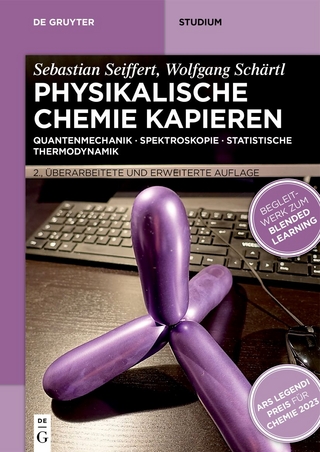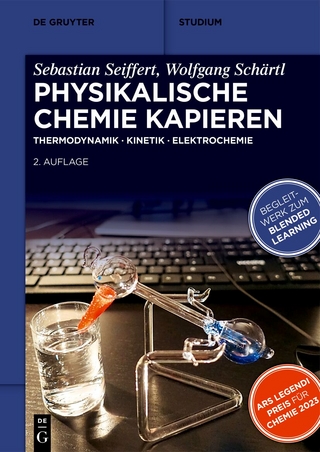
Thermal Physics & Statistical Mechanics
Seiten
2016
Arcler Education Inc (Verlag)
978-1-68094-436-5 (ISBN)
Arcler Education Inc (Verlag)
978-1-68094-436-5 (ISBN)
Outlines the ongoing research and development in modern Thermal Physics & Statistical Mechanics (TPSM). It is organised into three sections: Selected Topics in TPSM; Advanced Topics in TPSM; and Applications.
This book outlines the ongoing research and development in modern Thermal Physics & Statistical Mechanics (TPSM). It is organized into 3 sections: Selected Topics in TPSM, Advanced Topics in TPSM and Applications.
The first section starts by introducing the physical meaning of thermodynamic entropy, providing a historical context - from the Carnot’s reversible cycles to the modern definition of entropy. It continues further by discussing specific questions and methods. The first studies are concerned with a better comprehension of the thermodynamics of quantum systems and small individual systems. This includes the analysis of quantum systems where the energy is not the only quantity being conserved as well as the reproduction of locally defined entropy for small individual systems. Bose–Einstein condensation of a two-dimensional photon gas and its thermodynamic behaviour at the phase transition are also investigated. The remaining studies are focused on understanding the processes involving electron gas in composite materials. This include the study of the local interaction between an electron and a photon gas as mean to examine the the Kapitza resistance (thermal boundary resistance) behaviour, the analysis of quantum mechanical model (Jellium model) as alternative procedure to examine the relationship between the absolute power of metal and the partial molar entropy, and the testing of new algorithm for solving a system of three Boltzmann equations for three components in a mixture. The second section is centered on advanced TPSM methods and approaches which are being motivated by the technological progress, research and development in other fields such as Nanophotonics, Quantum Computing, High Energy Physics, and Cosmology. For instance, the analysis of quark ensembles by using a four-fermion approximation motivated by the potential quark–gluon plasma production at heavy-ion colliders, the investigation of Bose–Einstein condensation at finite density in the Rindler space is based on the Unruh effect and in the experimental research of black holes evaporation. Moreover, Burg’s maximum entropy, a method commonly used in data mining, can also be a promising tool for the analysis of complex systems such those encountered in TPSM. The use of different entropy measures (e.g. Boltzmann’s entropy, Shannon’s entropy, Burg’s modified entropy) as well as the study of quantum entanglement from the perspective of thermal quantum field theory, phases transitions of a fluid material with solid deformations, polarized relativistic matter, and non-equilibrium thermodynamics are discussed in great detail in this section. The remaining content of this book focuses on applications of TPSM in interdisciplinary research, for example, for the study viral evolution, coupled SQUIDs (superconducting quantum interference devices), polymers extrusion, nanofluids of ultra-thermal conductivity and transport processes in soft materials.
This book outlines the ongoing research and development in modern Thermal Physics & Statistical Mechanics (TPSM). It is organized into 3 sections: Selected Topics in TPSM, Advanced Topics in TPSM and Applications.
The first section starts by introducing the physical meaning of thermodynamic entropy, providing a historical context - from the Carnot’s reversible cycles to the modern definition of entropy. It continues further by discussing specific questions and methods. The first studies are concerned with a better comprehension of the thermodynamics of quantum systems and small individual systems. This includes the analysis of quantum systems where the energy is not the only quantity being conserved as well as the reproduction of locally defined entropy for small individual systems. Bose–Einstein condensation of a two-dimensional photon gas and its thermodynamic behaviour at the phase transition are also investigated. The remaining studies are focused on understanding the processes involving electron gas in composite materials. This include the study of the local interaction between an electron and a photon gas as mean to examine the the Kapitza resistance (thermal boundary resistance) behaviour, the analysis of quantum mechanical model (Jellium model) as alternative procedure to examine the relationship between the absolute power of metal and the partial molar entropy, and the testing of new algorithm for solving a system of three Boltzmann equations for three components in a mixture. The second section is centered on advanced TPSM methods and approaches which are being motivated by the technological progress, research and development in other fields such as Nanophotonics, Quantum Computing, High Energy Physics, and Cosmology. For instance, the analysis of quark ensembles by using a four-fermion approximation motivated by the potential quark–gluon plasma production at heavy-ion colliders, the investigation of Bose–Einstein condensation at finite density in the Rindler space is based on the Unruh effect and in the experimental research of black holes evaporation. Moreover, Burg’s maximum entropy, a method commonly used in data mining, can also be a promising tool for the analysis of complex systems such those encountered in TPSM. The use of different entropy measures (e.g. Boltzmann’s entropy, Shannon’s entropy, Burg’s modified entropy) as well as the study of quantum entanglement from the perspective of thermal quantum field theory, phases transitions of a fluid material with solid deformations, polarized relativistic matter, and non-equilibrium thermodynamics are discussed in great detail in this section. The remaining content of this book focuses on applications of TPSM in interdisciplinary research, for example, for the study viral evolution, coupled SQUIDs (superconducting quantum interference devices), polymers extrusion, nanofluids of ultra-thermal conductivity and transport processes in soft materials.
Olga Moreira obtained her Ph.D. in Astrophysics from the University of Liege (Belgium) in 2010, her BSc. in Physics and Applied Mathematics from the University of Porto (Portugal). Her post-graduate travels and international collaborations with the European Space Agency (ESA) and European Southern Observatory (ESO) led to great personal and professional growth as a scientist. Currently, she is working as an independent researcher, technical writer, and editor in the fields of Mathematics, Physics, Astronomy and Astrophysics.
| Erscheinungsdatum | 20.03.2018 |
|---|---|
| Sprache | englisch |
| Maße | 152 x 229 mm |
| Themenwelt | Naturwissenschaften ► Chemie ► Physikalische Chemie |
| Naturwissenschaften ► Physik / Astronomie ► Thermodynamik | |
| ISBN-10 | 1-68094-436-3 / 1680944363 |
| ISBN-13 | 978-1-68094-436-5 / 9781680944365 |
| Zustand | Neuware |
| Informationen gemäß Produktsicherheitsverordnung (GPSR) | |
| Haben Sie eine Frage zum Produkt? |
Mehr entdecken
aus dem Bereich
aus dem Bereich
Quantenmechanik | Spektroskopie | Statistische Thermodynamik
Buch | Softcover (2024)
De Gruyter (Verlag)
59,95 €
Set aus Lehrbuch und Arbeitsbuch
Buch | Hardcover (2022)
Wiley-VCH (Verlag)
109,00 €
Thermodynamik | Kinetik | Elektrochemie
Buch | Softcover (2024)
De Gruyter (Verlag)
59,95 €


